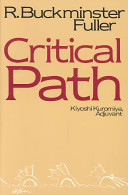The Origin of Trigonometry
Trigonometry had to start with sea-people. It is the conclusion of British, German, and U.S.A. navies' experts that celestial—offshore—navigation be¬ gan with the South Pacific's island peoples. Much has been published on this subject. What is not as well pubHshed is the fact that the navigators on all those islands live entirely apart from the other humans in their native groups.
When the supposedly God-ordained chieftain of those islands finds his prestige and popular credence declining, he can go to the navigator and ask him to produce a miracle. The chieftain does not know of the navigator as such. The chieftain knows naught of navigation. He thinks of the navigator as a magician or miracle-maker. All the chieftain knows is that his miracleproducer goes off* to sea sailing his catamaran out of sight on the ocean. The navigator, using his well remembered, unique pattemings of the stars and the ocean currents, water temperatures, and major "old-seas" patterns, goes items such as have never been and probably never will be found on the home items such as have never been and probably never will be found on the home island. The navigator brings this foreign item back to the island king-chief¬ tain, who displays it before the people, who spontaneously assume that the chieftain has conjured the strange object into existence with his divine pow¬ ers—and the chieftain's accreditation as being divinely instituted is restored.
)mprehend later, prehistory's successors of the ancient navigators eventually became the high priests of Egypt, Babylon, and other great civilizations. Both their evolutingly developed mathematical calculating capability and their navigational intuiting ultimately led to their discovery that theEarth is a circumnavigatable sphere. This knowledge made them more powerful than the physically powerful fighting kings.
Offshore, with no familiar landmarks to guide them, early water-peoples learned through necessity and invention how to sail their ships on courses running between any two well-recognized stars co-occurring diametrically opposite one another above the sky's circular horizon at various given times of the night and reliably reappearing in the same pattern in any geograph¬ ical area on any given day of the year. Any two prominent, easy-to-recognize stars in the sky gave the unique course for the ship to follow. The point on the mast, B, at which the bright star in the sky toward which they sailed occurred at any given time of observation, and the point C, at which the boom of their sail contacted the mast, and the point A, at which the stemstanding or -sitting helmsman's eye occurs, gave the three comer points of a right triangle whose three angles. A, B, and C, always sum-totalled 180 degrees. This 180-degree sum-total angular constancy of any plane triangle formed the basis of all plane trigonometry.
If one of the three angles of a triangle is a right angle, then all the vari¬ ation takes place only between the two other angles, whose angular s' sum will always equal that of the constant right angle (ninety degrees).
With their ship's (or raft's) masts mounted perpendicularly (at right angles, vertically) to their ship's or hull's waterline, they steered the ship at night by keeping the mast always lined on the approached star—as long as the Earth's rotation allowed the sight of that star to remain in a usable line of sight. The angle of elevation of the approached star could be sightingly measured by the helmsman observing, from the stem, the star's everchanging height on the mast as sightingly identified, for instance, by the mast's sail-lufF rings, which elevation altered as the Earth revolved during the night within the spheric array of Universe stars. With days, months, years, and lifetimes of such observing, measuring, and calculating, the seapeople gradually evolved trigonometry. (See Fig. 7.)
Notes:
Is in the history of ship navigation.
Folksonomies: history mathematics trigonometry
Taxonomies:
/art and entertainment/music/music genres/opera (0.473815)
/sports/sailing (0.380625)
/science/mathematics/geometry (0.364803)
Keywords:
supposedly God-ordained chieftain (0.957548 (neutral:0.000000)), celestial—offshore—navigation be¬ gan (0.839909 (positive:0.245211)), island king-chief¬ tain (0.807950 (positive:0.251577)), sum-total angular constancy (0.798005 (neutral:0.000000)), geograph¬ ical area (0.794229 (neutral:0.000000)), mathematical calculating capability (0.793635 (positive:0.363011)), various given times (0.787784 (neutral:0.000000)), constant right angle (0.785692 (positive:0.230492)), physically powerful fighting (0.777329 (positive:0.735663)), navigator (0.714495 (positive:0.303659)), plane trigonometry (0.690641 (neutral:0.000000)), U.S.A. navies (0.690391 (neutral:0.000000)), South Pacific (0.684726 (positive:0.245211)), ship navigation (0.684144 (neutral:0.000000)), right angles (0.683349 (positive:0.271188)), popular credence (0.680996 (neutral:0.000000)), island peoples (0.677921 (positive:0.245211)), native groups (0.673058 (negative:-0.231638)), well-recognized stars (0.672724 (neutral:0.000000)), ancient navigators (0.670225 (neutral:0.000000)), sea sailing (0.667678 (neutral:0.000000)), water temperatures (0.665976 (neutral:0.000000)), ocean currents (0.664459 (positive:0.393352)), unique pattemings (0.663494 (positive:0.393352)), great civilizations (0.660925 (positive:0.342370)), home island (0.660809 (negative:-0.313842)), foreign item (0.660496 (positive:0.251577)), right triangle (0.660480 (neutral:0.000000)), circumnavigatable sphere (0.660266 (positive:0.363011)), home items (0.659632 (negative:-0.313842))
Entities:
theEarth:Company (0.913626 (positive:0.363011)), U.S.A.:Country (0.846336 (neutral:0.000000)), South Pacific:Region (0.828096 (positive:0.245211)), Babylon:City (0.745366 (neutral:0.000000)), Egypt:Country (0.736864 (neutral:0.000000)), ninety degrees:Quantity (0.736864 (neutral:0.000000)), 180 degrees:Quantity (0.736864 (neutral:0.000000)), 180-degree:Quantity (0.736864 (neutral:0.000000))
Concepts:
Angle (0.967799): dbpedia | freebase
Hypotenuse (0.816376): dbpedia | freebase
Trigonometry (0.718765): dbpedia | freebase
Right angle (0.709165): dbpedia | freebase
Navigation (0.687650): dbpedia | freebase
Right triangle (0.680599): dbpedia | freebase
Cartesian coordinate system (0.500979): dbpedia | freebase | opencyc | yago
Triangle (0.465247): dbpedia | freebase | opencyc

Triples
 Trigonometry on the High Seas
Trigonometry on the High Seas
The Importance of Mathematics in Seafaring > Similarity > The Origin of TrigonometryEarly sailors had to be excellent mathematicians.




